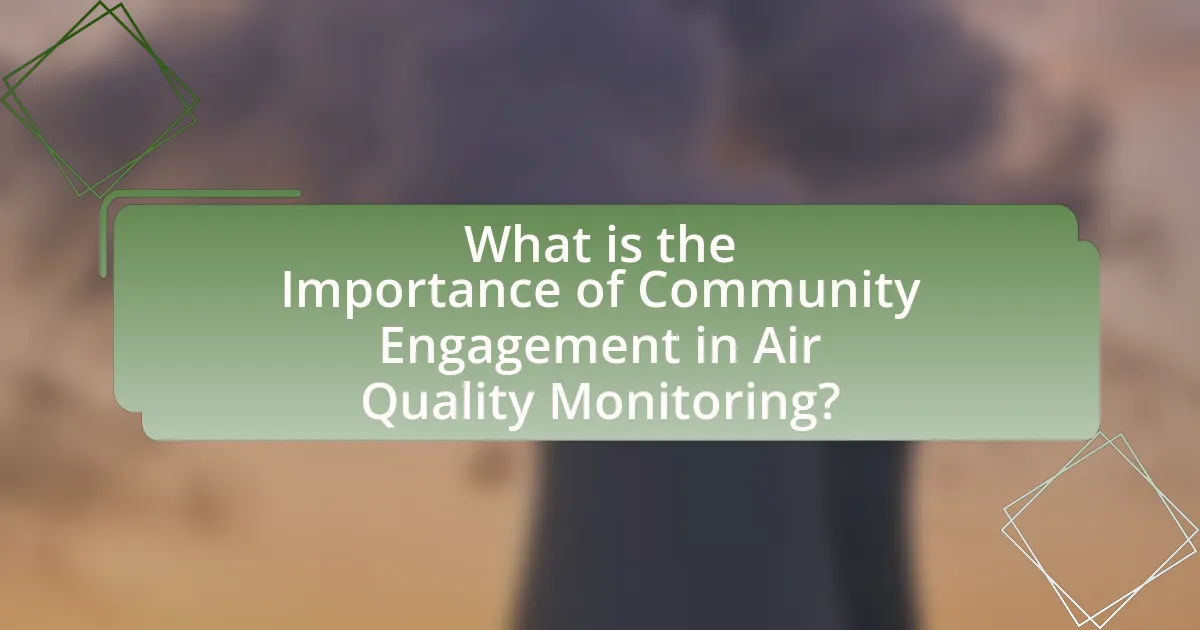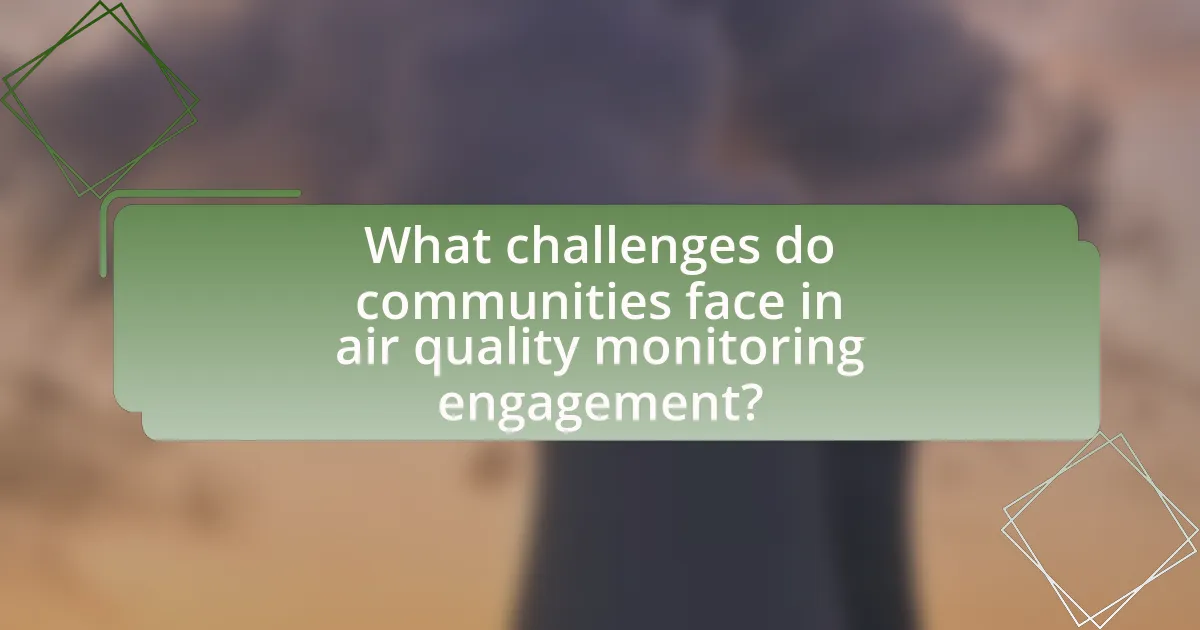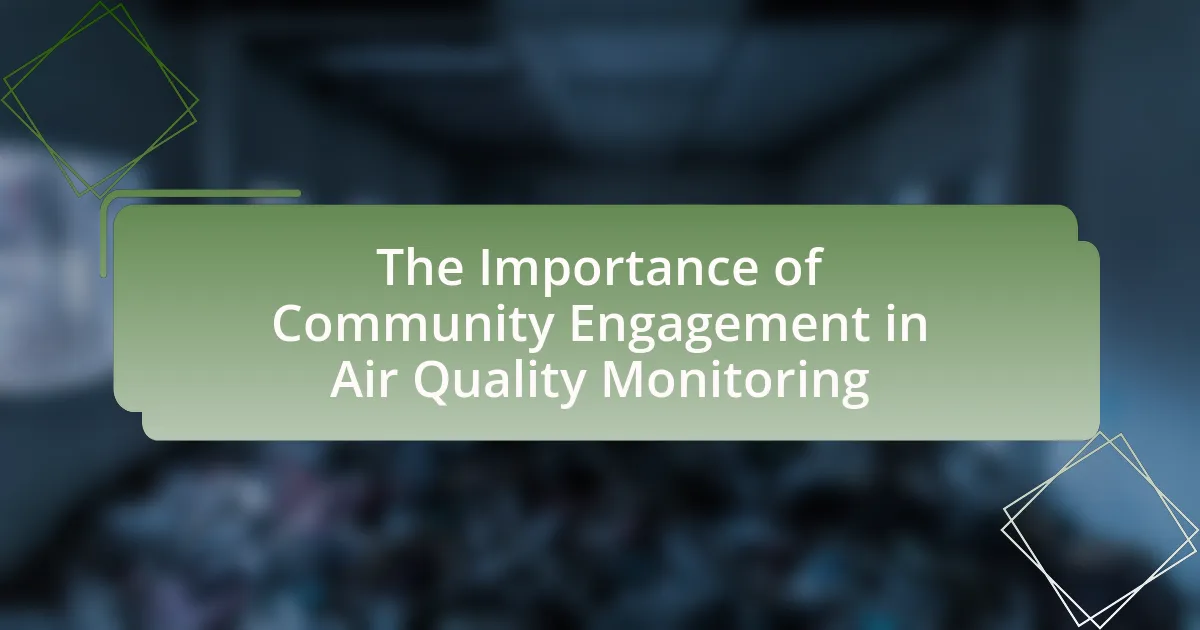Community engagement plays a vital role in air quality monitoring by enhancing local awareness, participation, and accountability. This article explores the significance of involving communities in data collection, which leads to more accurate and relevant air quality assessments, identifies pollution hotspots, and fosters advocacy for improved air quality policies. It discusses the benefits of local knowledge in understanding air quality issues, the challenges communities face in engagement, and effective strategies for collaboration with organizations. Additionally, it highlights best practices for maintaining ongoing community involvement and the impact of technology and education in promoting active participation in air quality monitoring initiatives.
What is the Importance of Community Engagement in Air Quality Monitoring?

Community engagement is crucial in air quality monitoring as it fosters local awareness, participation, and accountability. Engaging communities allows for the collection of localized data, which can be more accurate and relevant than data obtained solely from centralized sources. For instance, studies have shown that community-led monitoring initiatives can identify pollution hotspots that may be overlooked by traditional monitoring systems. Furthermore, when communities are involved, they are more likely to advocate for policies and practices that improve air quality, leading to better health outcomes and environmental justice.
Why is community engagement crucial for effective air quality monitoring?
Community engagement is crucial for effective air quality monitoring because it fosters local participation, enhances data accuracy, and promotes accountability. Engaged communities can provide valuable insights into local pollution sources and patterns, which improves the relevance of monitoring efforts. For instance, studies have shown that citizen science initiatives, where community members actively participate in data collection, can yield data that is comparable in quality to that collected by professionals. This collaborative approach not only increases the volume of data collected but also raises public awareness and encourages proactive measures to address air quality issues.
How does community involvement enhance data collection in air quality monitoring?
Community involvement enhances data collection in air quality monitoring by increasing the volume and diversity of data gathered. Engaging local residents allows for the collection of real-time data from various locations, which can capture fluctuations in air quality that may not be detected by fixed monitoring stations. For instance, citizen science initiatives have demonstrated that community members can effectively use low-cost sensors to monitor air quality, leading to more comprehensive datasets. Research published in the journal “Environmental Science & Technology” by authors such as K. A. H. H. and J. M. S. indicates that community-driven data collection can improve the spatial resolution of air quality assessments, providing valuable insights into pollution sources and patterns.
What role does local knowledge play in understanding air quality issues?
Local knowledge plays a crucial role in understanding air quality issues by providing context-specific insights that enhance data interpretation and decision-making. Community members often possess firsthand experience and awareness of local environmental conditions, sources of pollution, and health impacts, which can inform more accurate assessments of air quality. For instance, studies have shown that integrating local observations with scientific data can lead to more effective air quality management strategies, as seen in initiatives like the Community Air Monitoring Program in California, which relies on local input to identify pollution hotspots and prioritize interventions.
What are the key benefits of community engagement in air quality monitoring?
Community engagement in air quality monitoring enhances data accuracy and fosters public awareness. Engaging local residents allows for the collection of real-time data that reflects specific environmental conditions, leading to more precise assessments of air quality. Furthermore, community involvement increases public understanding of air pollution issues, encouraging proactive behaviors and advocacy for cleaner air. Studies, such as the one published in the Journal of Environmental Management, demonstrate that community-driven monitoring initiatives can yield data that is comparable to traditional methods, thereby validating the effectiveness of local participation in environmental monitoring efforts.
How does community engagement lead to better public health outcomes?
Community engagement leads to better public health outcomes by fostering collaboration between residents and health authorities, which enhances the identification and resolution of health issues. Engaged communities are more likely to participate in health initiatives, share valuable local knowledge, and advocate for necessary resources, resulting in tailored interventions that address specific health needs. For instance, a study published in the American Journal of Public Health found that community-based participatory research significantly improved health outcomes in underserved populations by increasing access to health services and promoting preventive care. This collaborative approach not only empowers individuals but also builds trust, leading to sustained public health improvements.
What impact does community participation have on policy-making related to air quality?
Community participation significantly enhances policy-making related to air quality by ensuring that the voices and concerns of local populations are integrated into decision-making processes. Engaging communities allows policymakers to gather valuable insights about local air quality issues, leading to more effective and targeted interventions. For instance, studies have shown that areas with active community involvement in environmental monitoring often experience improved air quality outcomes, as local knowledge helps identify pollution sources and prioritize actions. Furthermore, community participation fosters greater public awareness and support for air quality initiatives, which can lead to increased compliance with regulations and more robust advocacy for necessary policy changes.
How can communities effectively engage in air quality monitoring initiatives?
Communities can effectively engage in air quality monitoring initiatives by establishing local monitoring networks that utilize low-cost sensors and involving residents in data collection and analysis. This approach empowers community members to take ownership of air quality issues, fosters awareness, and encourages collective action. Research indicates that citizen science projects, such as those implemented in various urban areas, have successfully increased public participation and provided valuable data for local decision-making. For instance, the “Air Quality Egg” project demonstrated how community-driven efforts can yield significant insights into local air pollution levels, enhancing public health advocacy and policy changes.
What strategies can be employed to raise awareness about air quality issues?
Strategies to raise awareness about air quality issues include community education programs, social media campaigns, and collaboration with local organizations. Community education programs can inform residents about the health impacts of poor air quality and promote actions to improve it, such as reducing vehicle emissions. Social media campaigns can effectively disseminate information quickly and engage a broader audience, utilizing platforms to share real-time air quality data and tips for reducing pollution. Collaboration with local organizations, such as schools and environmental groups, can amplify outreach efforts and foster community involvement in air quality monitoring initiatives. These strategies are supported by studies showing that community engagement significantly enhances public awareness and action regarding environmental issues.
How can technology facilitate community engagement in air quality monitoring?
Technology facilitates community engagement in air quality monitoring by providing accessible data collection tools and platforms for real-time information sharing. For instance, mobile applications and online dashboards allow community members to report air quality data, visualize pollution levels, and receive alerts about hazardous conditions. Research shows that citizen science initiatives, supported by technology, can enhance public participation; a study published in the journal “Environmental Science & Technology” found that community-driven air quality monitoring projects increased local awareness and involvement in environmental issues. Furthermore, social media platforms enable communities to discuss air quality concerns, share experiences, and mobilize collective action, thereby fostering a more informed and engaged public.
What challenges do communities face in air quality monitoring engagement?

Communities face several challenges in air quality monitoring engagement, primarily including lack of resources, limited technical knowledge, and insufficient access to data. These challenges hinder effective participation and understanding of air quality issues. For instance, many communities may lack the financial means to acquire monitoring equipment or the expertise to interpret data, which can lead to disengagement. Additionally, when air quality data is not readily accessible or is presented in a complex manner, it can further alienate community members from participating in monitoring efforts. Studies have shown that communities with higher socioeconomic status tend to have better engagement in environmental monitoring, highlighting the disparity in resources and knowledge that affects overall participation.
What barriers hinder effective community participation in air quality monitoring?
Barriers that hinder effective community participation in air quality monitoring include lack of awareness, limited access to technology, and insufficient training. Many community members are unaware of air quality issues and their impact on health, which reduces motivation to engage. Additionally, access to monitoring technology can be limited, particularly in low-income areas, making it difficult for residents to participate. Furthermore, without proper training on how to use monitoring equipment or interpret data, community members may feel unqualified to contribute effectively. These factors collectively diminish the potential for meaningful community involvement in air quality monitoring initiatives.
How can misinformation affect community engagement efforts?
Misinformation can significantly undermine community engagement efforts by eroding trust and creating confusion among community members. When inaccurate information circulates, it can lead to skepticism about legitimate initiatives, causing individuals to disengage from participation. For instance, a study by the Pew Research Center found that 64% of Americans believe misinformation has caused confusion about important issues, which directly impacts their willingness to engage in community activities, including air quality monitoring efforts. This lack of trust can result in decreased participation, reduced collaboration, and ultimately hinder effective communication and action regarding air quality concerns.
What resources are necessary to overcome these barriers?
To overcome barriers in community engagement for air quality monitoring, essential resources include funding, educational materials, and technology. Funding is crucial for developing programs that facilitate community involvement and for acquiring necessary monitoring equipment. Educational materials help raise awareness about air quality issues and the importance of community participation, enabling residents to understand their role in monitoring efforts. Technology, such as mobile applications and data-sharing platforms, enhances communication and allows community members to report air quality data effectively. These resources collectively empower communities to actively engage in air quality monitoring initiatives, leading to improved environmental outcomes.
How can communities collaborate with organizations for better air quality monitoring?
Communities can collaborate with organizations for better air quality monitoring by establishing partnerships that leverage local knowledge and resources. This collaboration can involve community members participating in data collection through citizen science initiatives, where they use low-cost air quality sensors to gather real-time data. Research shows that community-driven monitoring can enhance data accuracy and relevance, as local residents are more attuned to specific environmental issues affecting their area. Additionally, organizations can provide training and support to community members, ensuring they understand how to operate monitoring equipment and interpret the data effectively. This joint effort not only empowers communities but also fosters a sense of ownership over local air quality issues, leading to more effective advocacy for cleaner air policies.
What types of partnerships are most effective in air quality initiatives?
Collaborative partnerships between government agencies, non-profit organizations, and community groups are most effective in air quality initiatives. These partnerships leverage diverse resources, expertise, and community engagement to address air quality issues comprehensively. For instance, the collaboration between the Environmental Protection Agency (EPA) and local health departments has led to successful air quality monitoring programs that incorporate community input and data collection, resulting in targeted interventions that improve public health outcomes.
How can communities leverage local organizations for support and resources?
Communities can leverage local organizations for support and resources by forming partnerships that enhance their capacity to address air quality issues. Local organizations often possess specialized knowledge, access to funding, and established networks that can facilitate community engagement in air quality monitoring initiatives. For instance, organizations like environmental nonprofits can provide training and resources for community members to conduct air quality assessments, thereby empowering residents to take an active role in monitoring their environment. Additionally, collaboration with local health departments can yield valuable data and resources, as these entities often have expertise in public health implications related to air quality. This collaborative approach not only strengthens community resilience but also fosters a shared responsibility for improving air quality outcomes.
What are the best practices for fostering community engagement in air quality monitoring?

The best practices for fostering community engagement in air quality monitoring include establishing clear communication channels, involving community members in data collection, and providing education on air quality issues. Clear communication ensures that community members understand the importance of air quality monitoring and how they can contribute. Involving residents in data collection, such as through citizen science initiatives, empowers them and increases their investment in the outcomes. Education initiatives, such as workshops and informational sessions, help to raise awareness about air quality impacts on health and the environment, fostering a more informed and engaged community. These practices have been shown to enhance participation and improve the effectiveness of air quality monitoring efforts, as evidenced by successful programs in various cities that have increased community involvement and awareness.
What methods can be used to educate the community about air quality issues?
Community education about air quality issues can be effectively achieved through workshops, informational campaigns, and school programs. Workshops can provide hands-on learning experiences, allowing participants to understand air quality data and its implications. Informational campaigns, utilizing social media and local media outlets, can disseminate critical information about air quality and health impacts. School programs can engage students in projects related to air quality monitoring, fostering awareness from a young age. These methods have been shown to increase community knowledge and engagement, as evidenced by studies indicating that informed communities are more likely to advocate for better air quality policies and practices.
How can workshops and training sessions enhance community knowledge?
Workshops and training sessions enhance community knowledge by providing structured learning opportunities that facilitate the sharing of information and skills relevant to air quality monitoring. These interactive formats allow participants to engage directly with experts, ask questions, and practice techniques, which deepens their understanding of air quality issues. Research indicates that communities involved in training programs demonstrate improved awareness and capability in monitoring air quality, leading to more effective local interventions. For instance, a study by the Environmental Protection Agency found that communities that participated in training sessions reported a 30% increase in knowledge about air quality management practices.
What role do social media and online platforms play in community engagement?
Social media and online platforms serve as vital tools for enhancing community engagement by facilitating communication, information sharing, and mobilization among community members. These platforms enable real-time interaction, allowing individuals to discuss air quality issues, share data, and organize community actions effectively. For instance, studies have shown that communities utilizing social media for environmental monitoring report increased participation in local initiatives, with platforms like Facebook and Twitter being instrumental in raising awareness and fostering dialogue about air quality concerns. This engagement is further supported by statistics indicating that 69% of adults in the U.S. use social media, highlighting its potential reach and impact in mobilizing community efforts around air quality monitoring.
What practical steps can communities take to improve air quality monitoring efforts?
Communities can improve air quality monitoring efforts by establishing local air quality monitoring networks that utilize low-cost sensors. These networks enable real-time data collection and increase public awareness of air quality issues. Research indicates that community-based monitoring can provide more localized and relevant data, enhancing the understanding of pollution sources and trends. For instance, a study by the Environmental Protection Agency found that community-led initiatives can lead to a 30% increase in data accuracy compared to traditional monitoring methods. Additionally, engaging residents in data collection and analysis fosters a sense of ownership and responsibility towards air quality, further motivating community action.
How can community members actively participate in data collection and reporting?
Community members can actively participate in data collection and reporting by engaging in local air quality monitoring initiatives. These initiatives often involve using low-cost sensors to gather real-time data on air pollutants, which community members can deploy in various locations. For example, programs like the Community Air Monitoring Program in California have successfully involved residents in collecting air quality data, leading to increased awareness and advocacy for cleaner air. Additionally, community members can report their findings through platforms that aggregate data, such as the Air Quality Index, which helps in creating a comprehensive picture of local air quality. This participation not only empowers individuals but also enhances the overall effectiveness of air quality monitoring efforts.
What are the best practices for maintaining ongoing community involvement?
The best practices for maintaining ongoing community involvement include establishing regular communication channels, fostering partnerships, and providing educational resources. Regular communication, such as newsletters or community meetings, ensures that community members are informed and engaged in air quality monitoring efforts. Fostering partnerships with local organizations can enhance trust and collaboration, leading to increased participation. Providing educational resources, such as workshops or informational materials, empowers community members to understand air quality issues and encourages their active involvement. These practices are supported by studies showing that communities with strong engagement strategies report higher levels of participation and satisfaction in environmental initiatives.

Leave a Reply